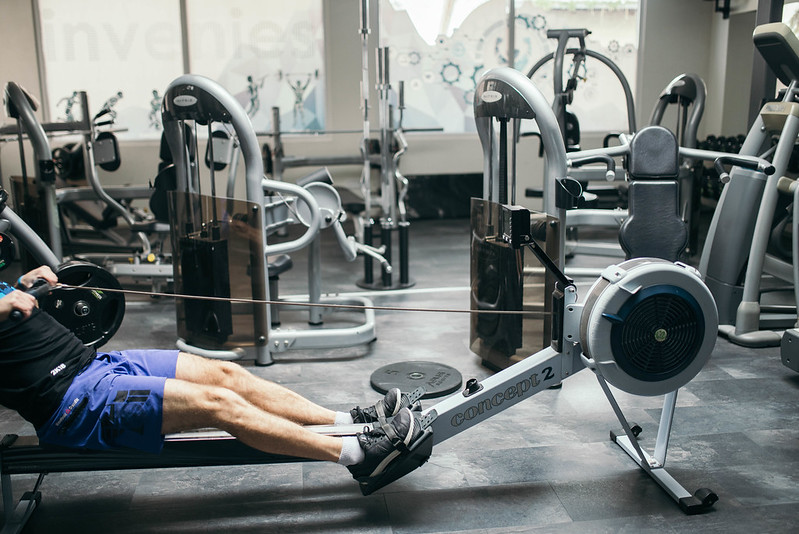Ready to finally get into shape?
Awesome!
You have a lot of choices ahead of you for how to get started.
You could:
- Start running
- Take up yoga
- Pick up some heavy weights
Or, for our purposes, you could buy a rowing machine — or start frequenting a gym that has them.
In this post, we’ll break down all of the rowing machine pros and cons to help you decide… is it the right workout for you?

Rowing is a phenomenal full-body workout that supercharges your conditioning and helps build muscle over your entire body. In terms of efficiency, it’s one of the best forms of exercise around — and the strength you gain from your rowing machine will be functional and athletic.
On the other hand, rowing can be extraordinarily tedious and hard to stick to over the long haul. And while rowing can help you lose fat and build muscle, it’s unlikely you’ll get “jacked” just from using your rowing machine without adding in weight lifting exercises.
Of course, rowing may not be right for everyone. Keep reading through our pros and cons of this exercise method to decide if using the rowing machine is right for you.
Pros of Rowing Machines (Benefits)
There’s a lot you’ll immediately love about rowing machines.
You may have seen them at the gym. They tend to be less crowded than the treadmills and bikes. But once you get started, you’ll find they give you an excellent workout even if you’re only on it for 30 minutes a day.
Let’s jump right into all of the good stuff.
A Full-Body Strength & Conditioning Workout
Many workouts are designed to target one specific area of the body, sometimes in addition to giving you a cardio workout.
Running challenges your conditioning and works your legs.
Squats work your lower body and core. Bicep curls work, well, your biceps.
The great thing about a rowing machine is that it delivers a full-body workout where you’re challenging numerous muscles at once.
According to Livestrong, some of the muscles you can expect to focus on with a rowing machine include your:
- Hips
- Glutes
- Legs
- Back
- Shoulders
- Arms
As a result, you get an exceptional cardiovascular workout that also tones muscles at multiple points of your body.
Just don’t expect to get jacked.
A good way to decide if you want to do a certain kind of workout is to look at the physiques of high-level people in that sport, then compare it to your dream bod.
Collegiate and professional rowers are often quite lean and strong without being bulky, with solid development in both their upper and lower bodies. Some would argue it’s the ideal look!
And it’s all thanks to TONS of rowing.

You know when you spend some time on the rowing machine, you’re really getting your money’s worth. That leads us into our next point…
A More Affordable Piece of Equipment
Naturally, you’ll find a wide range of prices out there when you’re shopping for home exercise equipment.
You can find many rowing machines that cost somewhere in between $180 and $400. However, if you really want to splurge, then there are models out there that cost up to $1,250.
Meanwhile, a top-quality treadmill could set you back up to $4,000. Naturally, you can find treadmills that cost a lot less, especially if you decide to buy used.
When it comes to getting the most bang for your buck, a rowing machine is where it’s at.
After all, you’re spending that money for both a cardiovascular and muscle strengthening workout. Other devices will only focus on one or the other.
(You can also join a good gym for about $30-50 per month and also get access to group classes and other workout equipment. But if you just want to focus on rowing, buying your own machine is the better deal.)
A Great Way to Burn Calories
There are numerous factors that go into how many calories you’ll burn with any given exercise.
But according to Harvard Health Publications, a 185-pound person can expect to burn 311 calories in 30 minutes of moderate activity on a rowing machine.
That’s one of the best calorie burn rates around.
You can burn even more with extreme rowing, but you want to make sure you work your way up to that point.
Ultimately, you can expect to burn a lot more on a rowing machine than other devices. This is because rowing engages nearly all of the muscles in your body rather than just a few.
Rowing is a great way to feel the burn. Just make sure to work at a reasonable pace, starting slow and working your way up to greater intensity.
(Does rowing help you lose weight? Yes — if you eat the right number of calories. Using a rowing machine burns a ton of calories but if you eat them all back, you won’t lose fat. The strength and conditioning gains, however, will be plentiful!)
A Low-Impact Workout
Finally, it’s important to look at how much safer rowing is compared to other exercises.
As opposed to running, you’re not putting an inordinate amount of stress on your knees, ankles, and joints.
Your legs may be in full motion, but they’re not hitting any hard surface repeatedly. It’s much more comfortable, and as a result, rowing is a recommended workout for anyone with knee issues.
It’s important to talk to your doctor before starting any new intense workout regimen. If you have a history of joint or leg problems in the past, then your doctor may even suggest rowing as a low-impact activity.
Just because you have some health issues doesn’t mean you can’t enjoy a full-bodied workout.
Cons of Rowing Machines (Disadvantages)
There’s a lot to love about rowing machines.
For some people, they’re an excellent way to work out several places of your body at once.
But like any other exercise, there are some drawbacks to consider.
Think of the following points before buying a rowing machine because you never know if it will end up being an ill-advised venture for you.
A Toll on the Lower Back
Before you start using a rowing machine, you want to make sure you read the instructions carefully. There is a specific technique you need to use to make sure you’re working out correctly.
Once you begin, you want to start slow. Avoid going too quickly because this can put a substantial strain on your lower back.
In general, rowing may not be advised if you suffer from a history of chronic back problems.
With rowing, you’re pulling a cord toward you while moving into an upright position. Then, you let the machine bring the cord back away from you.
In some people, this can put a toll on the lower back. As such, it’s not recommended for people with a history of spine or back problems to start rowing.
A Lot of Noise
Another item to consider is that rowing machines tend to be noisy.
This is especially true for air and water rowers. Every time you pull back, the machine makes a loud noise.
As a result, rowing machines may not be ideal if you live in an apartment or small house with other people. They may quickly get aggravated every time you try to work out because you’re making so much noise in the corner.
It doesn’t mean you have to completely disregard rowers. You can consider how often other people are in your home and when you would have some alone time with the rowing machine.
A Lot of Space
Even if you work around the noise issue, there’s the matter of space.
Again, people who live in an apartment or small house may find it difficult to find a good area to keep the rowing machine.
These devices have a big tank or flywheel in addition to tracks that take up a fair amount of your home gym.
(They’re usually about 8 feet long and need a few feet of width, as well.)
Fortunately, there can be a workaround for this.
Many rowing machines on the market are now foldable or collapsible. You fold it out when you need to work out, and then fold it back when it’s not in use.
You can move it to the center of the room when you want to work up a sweat and put it away in a closet or in the corner when you’re done.
Of course, the space and noise of a rowing machine won’t be an issue if you simply use them at the gym.
However…
Can Be Boring & Tedious
Like running, rowing is an ultra-repetitive movement.
You sit, pull, and return. Sit, pull, return.
You do this over and over and over, sometimes for an hour or more on end.
And that’s rowing!
Sounds boring, right?
Runners can at least venture outside to tackle trails and other paths. It’s not feasible for most people to regularly row in a boat on the water.
So you’re stuck in the gym or living room doing the same thing over and over.
You can mix up your rowing workouts by creating or following HIIT routines involving the rower.
When you combine rowing with other forms of cardio, HIIT, and weight lifting, you’ll see AMAZING results.
But beware. Boring workouts seem fine at first, when they’re effective, but can be tough to stick to over the long haul.
Wrapping Up
Now you’re up to speed on all the rowing machine pros and cons out there!
Ultimately, rowing is a great way to work out your entire body. It’s great for people who may not want to invest in buying or learning a lot of machines and just want one that covers pretty much everything.
You get cardio and muscle conditioning all in one, and that can be a major help when you want to improve your health.
However, rowing can be extremely boring when not paired with other forms of exercise, and it can be brutal on your back if you use bad form or go too hard too fast.
Is there anything we missed? For all of you who are already pros at rowing, what do you love most about these machines?
Hope this guide was helpful!